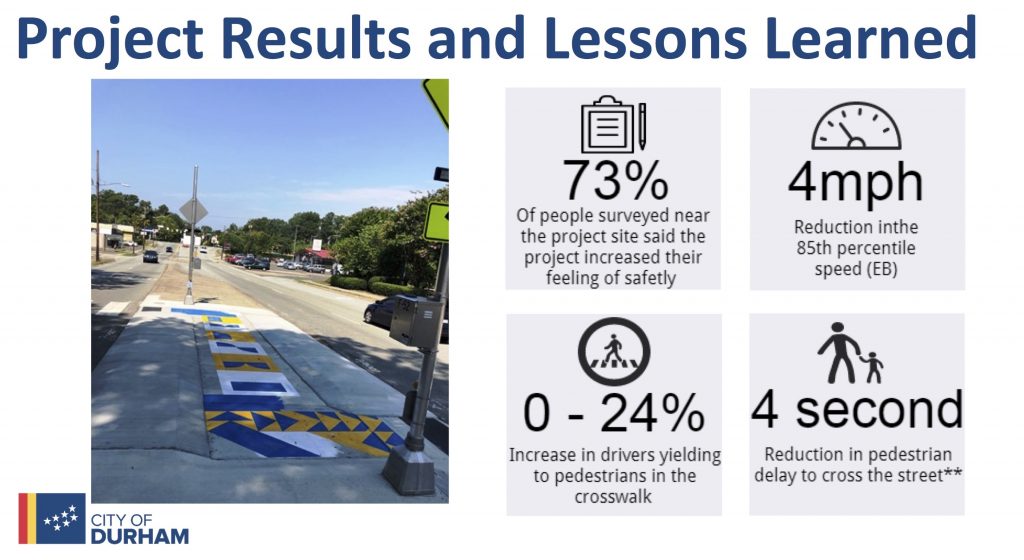
News
By Smart Growth America, August 14, 2019

Through the Safe Streets, Smart Cities Academy, Smart Growth America worked with three cities to implement temporary demonstration projects to create safer streets. This month, we released case studies telling the stories of these three projects. We also held a webinar with representatives from each of the three cities to share lessons learned from these projects, as well as update us on how the projects have evolved since the end of the Academy. You can watch the full recording of this webinar below or download a PDF of the presentations.
Questions?
We had so many great questions during the Q&A section of the webinar that we couldn’t get to all of them. We followed up with all three teams to discuss answers to some of the questions we missed.
Durham team: The artwork increased enthusiasm for the project. I expected that we would receive complaints from people who did not like either of the designs, but that was not the case. People seemed to enjoy the process of voting on the final concept for implementation. I think people often feel overwhelmed by having to provide comments on more complex transportation topics, but voting on the artwork concepts was accessible to people of all ages.
Huntsville team: Our mantra was that most of the official roadway marking books out there are “guidelines” rather than hard-and-fast rules. So, if our leadership is okay trying something new that is outside of the guidelines and the public who will benefit from the project like the concepts, then we move forward with the unique pavement art.
Durham team: We found that when discussing this project with the public, the data became key to overcoming any resistance. The results from our studies were uniformly positive and showed an improvement for vulnerable users of the road. The data collection was a larger undertaking than we’ve done in the past for other projects of this type, but it was a learning experience that we’d like to replicate for future projects. Even people who care more about driving, rather than walking or biking, will accept a certain amount of increased delay if it means a safer road for pedestrians or bicyclists.
Pittsburgh team: We used StatTrack traffic data collectors. They are the same units as the speed minders that our police department has used for years, but without the “your speed is” so drivers don’t know their speed is being recorded. We have six units we rotate around the city to collect data and prioritize streets for traffic calming or other measures.
Durham team: We used pneumatic tubes to collect before-and-after speed and volume data. We also conducted a before-and-after pedestrian study using a video camera. We took 10 hours of footage and recorded each pedestrian crossing, how long it took the pedestrian to begin his/her crossing and whether vehicles yielded. We will do another round of data collection in the next few weeks, now that the RRFB is installed.
Huntsville team: We had our traffic engineering staff as part of our team, and they helped guide us on what we could use and what was appropriate to use for the roadway changes. Some of the more temporary changes would have left us open to liability if used, as they were not approved for in-roadway use and breakaway/crash worthy. We did do some temporary things, they were just done in a more standard way.
Huntsville team: We used standard roadway marking paint and thermo for the crosswalk. We are also using some new brick looking thermos in the crosswalk to give it a more permeant feel.
Pittsburgh team: We used durable thermoplastic pavement markings since the pavement in our project area was in relatively good condition (the asphalt will likely last longer than the new pavement marking lifespan, which is 3-5 years). The city does not own a thermoplastic line striper or eradication machine, so we use an on-call contractor with a local striping company to eradicate existing pavements markings, and install the new thermoplastic crosswalks and line striping. We did not fill in some of the painted bump outs yet so there is the possibility of painting public art in them.
Huntsville team: We have a walk behind grinder and simply ground the old markings off and applied the new ones in the same area for the most part
Durham team: This is the first ground plane artwork in Durham and we have a few other upcoming projects on an art emphasis corridor. We want to see how long the materials used by the contractor will last. We suspect that it may last a couple of years because no one will be driving over the artwork. Whether we maintain the current design or implement a new one will depend on the public response to the artwork once it is fully installed.
Huntsville team: We discussed flooding and rain events with homeowners along the culvert adjacent to the greenway. We instructed our contractors to install the new multi-use path in such a way that water would not flow into the yards of neighbors. A history of flooding came up regularly when doing door-to-door outreach.
Related News

© 2025 Smart Growth America. All rights reserved
Site By3Lane Marketing
















